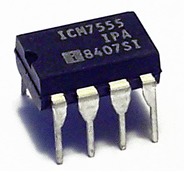If you feel threatened or need an urgent support in a crowd, use this alarm to catch the attention of others. It generates a loud siren simulating that of the Fire brigade which is enough to get support from others. A single press on the switch can activate the siren for 2 minutes and then it automatically stops. It is too small enough to keep in the pocket or hand bag. This circuit is quite compact and is powered by a button cell. The battery life is reasonable too and hence, it can be used for longer times without any power hassles.




 Fig. 4: Image Of ICM7555 IC
Fig. 4: Image Of ICM7555 IC
Since, this alarm goes OFF after a regular interval of time it can also be used as time-alert bell. The speaker used is not that powerful and hence, the alarm can be fairly restricted to personal usage too.
Circuit Diagrams
Filed Under: Electronic Projects



Questions related to this article?
👉Ask and discuss on EDAboard.com and Electro-Tech-Online.com forums.
Tell Us What You Think!!
You must be logged in to post a comment.